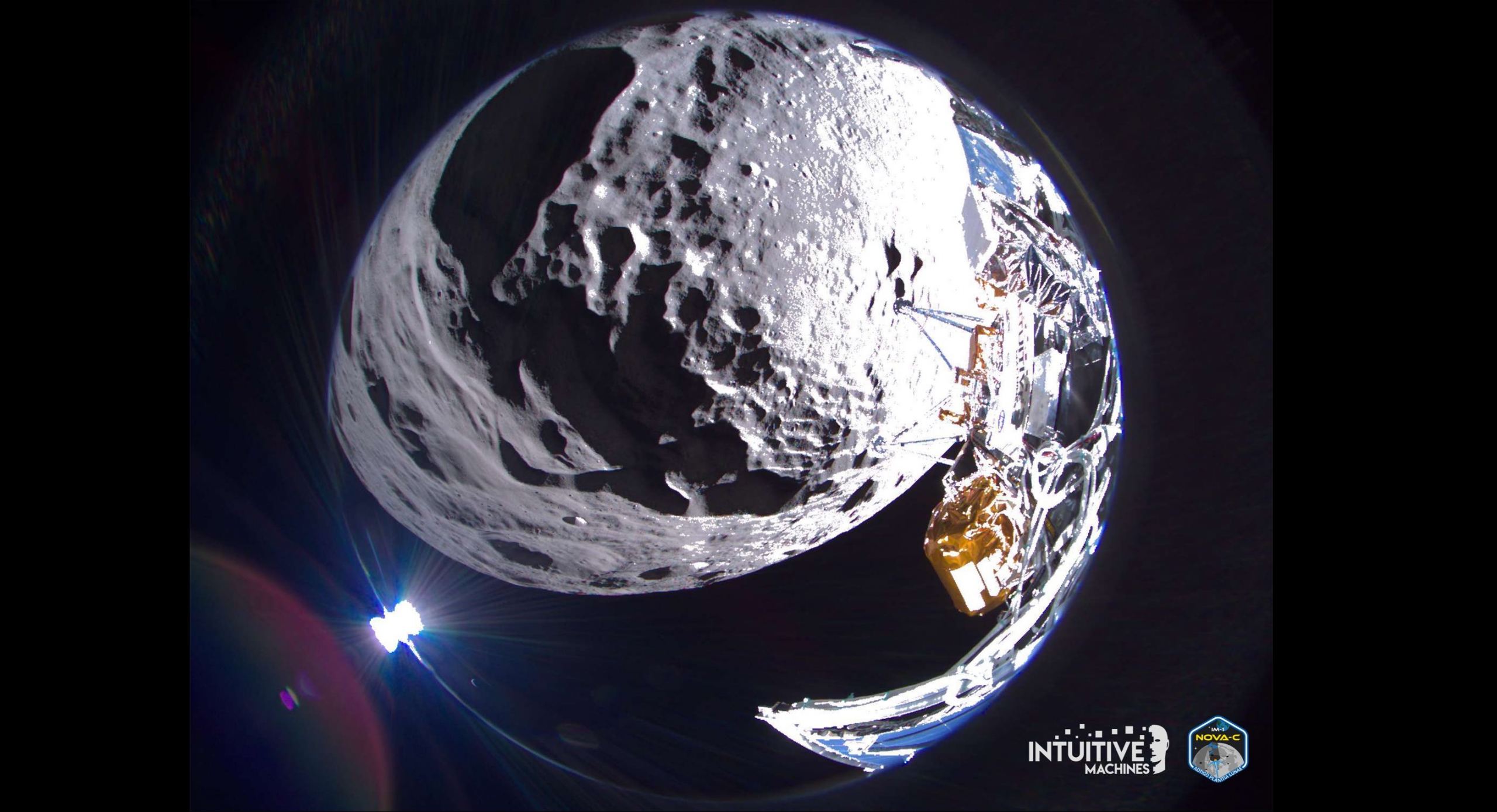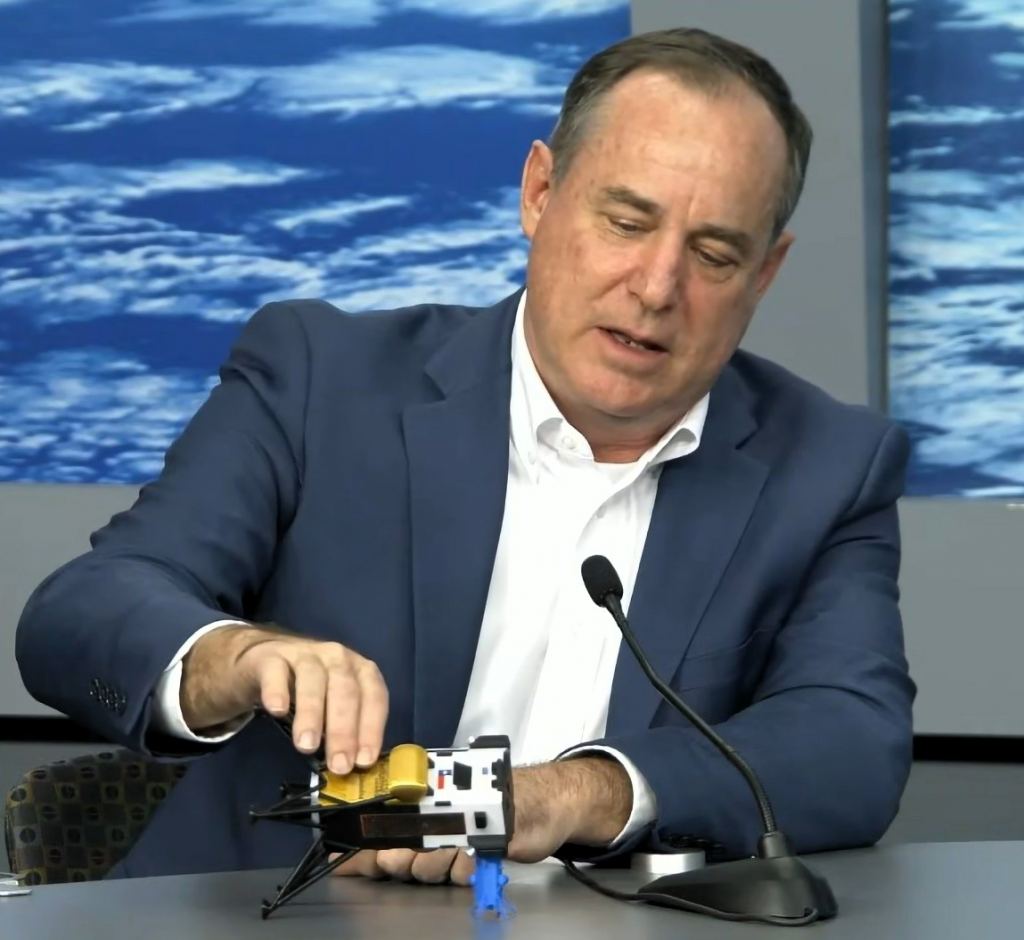The bad news is that Intuitive Machines' Odysseus lander is tipped on its side after getting tripped up during its touchdown near the south pole of the moon. The good news? The plucky robotic spacecraft is nevertheless able to send back data.
Mission managers at the Houston-based company and at NASA, which is paying $118 million to support Odysseus' space odyssey, are working on ways to maximize the scientific payback over the next nine or 10 days. "The vehicle is stable, near or at our intended landing site," Intuitive Machines CEO Steve Altemus said today during a post-landing briefing at NASA's Johnson Space Center. "We do have communications with the lander ... so that's phenomenal to begin with."
Just by surviving the descent a day earlier, Odysseus made it into the history books as the first commercial lander to arrive safely on the moon --- and the first U.S.-built spacecraft to do so since the Apollo 17 mission in 1972.
It wasn't easy: Mission managers discovered during a pre-landing maneuver that a safety lock on Odysseus's laser range-finding system hadn't been disengaged prior to the probe's Feb. 15 launch. That rendered the system inoperable.
Altemus said that when he told mission director Tim Crain that the spacecraft would have to land autonomously without its range-finders, "his face got absolutely white, because it was like a punch in the stomach that we were going to lose the mission." Fortunately, Crain and other mission team members figured out a way to reprogram Odysseus to make use of an experimental laser range-finding system that was included among NASA's payloads.
"In normal software development for spacecraft, this is the kind of thing that would have taken a month of writing down the math, cross-checking it with your colleagues, doing some simple calculations to prove the theory by putting it into a simulation, running that simulation 10,000 times evaluating performance," Crain said. "Our team basically did that in an hour and a half. And it worked."
Crain said it was serendipitous that the problem was identified during the pre-landing attempt to activate the range-finders. "We would have probably been five minutes to landing before we would have realized that those lasers weren't working, if we had not had that fortuitous event," he said. "So, serendipity is absolutely the right word."
The range-finder issue wasn't the only challenge: Odysseus came in for a landing faster than projected, with a downward velocity of 6 mph and sideward velocity of 2 mph. Altemus said the telemetry suggests that one of the lander's feet caught on something when it touched down, tipping the phone booth-sized spacecraft over onto its side. Based on its current attitude, Odysseus may be hung up on a rock, stuck in a crevasse or lying on a slope.
On the day of the landing, Intuitive Machines said Odysseus was upright, but today Altemus said that mistaken assessment was based on "stale telemetry" from the lander's fuel gauges.
Even though the lander is in an off-kilter position, some of its solar arrays are able to generate power, and some of its antennas are in the right orientation to communicate with ground stations back on Earth, Altemus said.
"We do have antennas, however, that are pointed at the surface, and those antennas are unusable for transmission back to Earth," he added. "And so, that really is a limiter. Our ability to communicate and get the right data down, so that we get everything we need for the mission, I think, is the most compromised from being on its side."
Mission managers are working to increase the flow of data --- including imagery that could show definitively how the lander is lying and whether there's any damage.
"As we get more telemetry and turn more things on, we'll be updating you over the coming days [about] the analysis and the reconstruction of the landing," Altemus said.
He said NASA's Lunar Reconnaissance Orbiter is due to fly over the landing area over the weekend and capture views from above. That should help Intuitive Machines and NASA figure out how close Odysseus came to its landing target, near a crater known as Malapert A.
Odysseus's primary mission is to collect data about the environment in the lunar south polar region. That area is of growing interest because its permanently shadowed craters are thought to contain reserves of water ice that could support future moon bases. NASA is planning to send a crew of astronauts to the lunar south polar region in 2026.
A 'spicy' mission to the moon
The past year has demonstrated just how tough it is to put a robotic lander on the moon. Last month, a different private company called Astrobotic missed its chance for a lunar landing when its Peregrine spacecraft developed a propellant leak after launch. Like Intuitive Machines, Astrobotic is providing commercial lunar delivery services for NASA.
Moon landing attempts by Russia's space agency and Japan's iSpace venture also fell short. On the plus side, India successfully sent a lander and a rover to the lunar surface last August. And in an eerie foreshadowing of Odysseus' mission, the Japanese Aerospace Exploration Agency's SLIM lander made it to the moon -- but tumbled onto its side.
Altemus acknowledged that Odysseus, which is named after a long-wandering hero in Greek mythology, didn't exactly encounter smooth sailing during its own odyssey. "It was quite a spicy seven-day mission to get to the moon," he said.
NASA's deputy associate administrator for exploration, Joel Kearns, praised Intuitive Machines for pulling it off.
"Let me congratulate Intuitive Machines for three major accomplishments," Kearns said. "The first is ... for having the first successful soft landing on the moon by the United States since 1972. The second is for being the first non-governmental commercial organization to actually touch down safely on the surface of the moon. And the third is, we're having a touchdown point 80 degrees south latitude, much closer to the south pole of the moon than any earlier U.S. robotic or human explorers."
Kearns said NASA has already received valuable data from Odysseus' transit to the moon, "and we're looking forward to get even more data as Intuitive Machines finishes the checkout of Odysseus."
What's ahead for Odysseus?
Altemus said it looks as if all of the active payloads should be able to keep collecting data. The only payload in an awkward position is a cube containing an array of mini-sculptures, which is on the lander's downward-facing side, he said.
A camera system called EagleCam presents a special case: EagleCam was designed to be deployed during the lander's descent and snap "selfies" of the touchdown, but because of the issue with the range-finding system, the payload had to stay put. Mission managers are currently planning to have the stationary lander eject EagleCam onto the surface to take pictures.
The end of Odysseus's mission is already drawing nigh. Crain said the lander's solar arrays will no longer be able to generate power when the sun sets at the landing site.
"Once the sun sets on Odie, the batteries will attempt to keep the vehicle warm and alive, but eventually it'll fall into a deep cold," Crain said
The lander's electronic circuits aren't designed to survive that chilly lunar night. "Best-case scenario, we're looking at another nine to 10 days," Crain said. "Of course, the next time the sun illuminates the solar arrays, we'll turn our dishes to the moon, just to see if the radios and the batteries and the flight computers survive that deep cold."
 Universe Today
Universe Today

